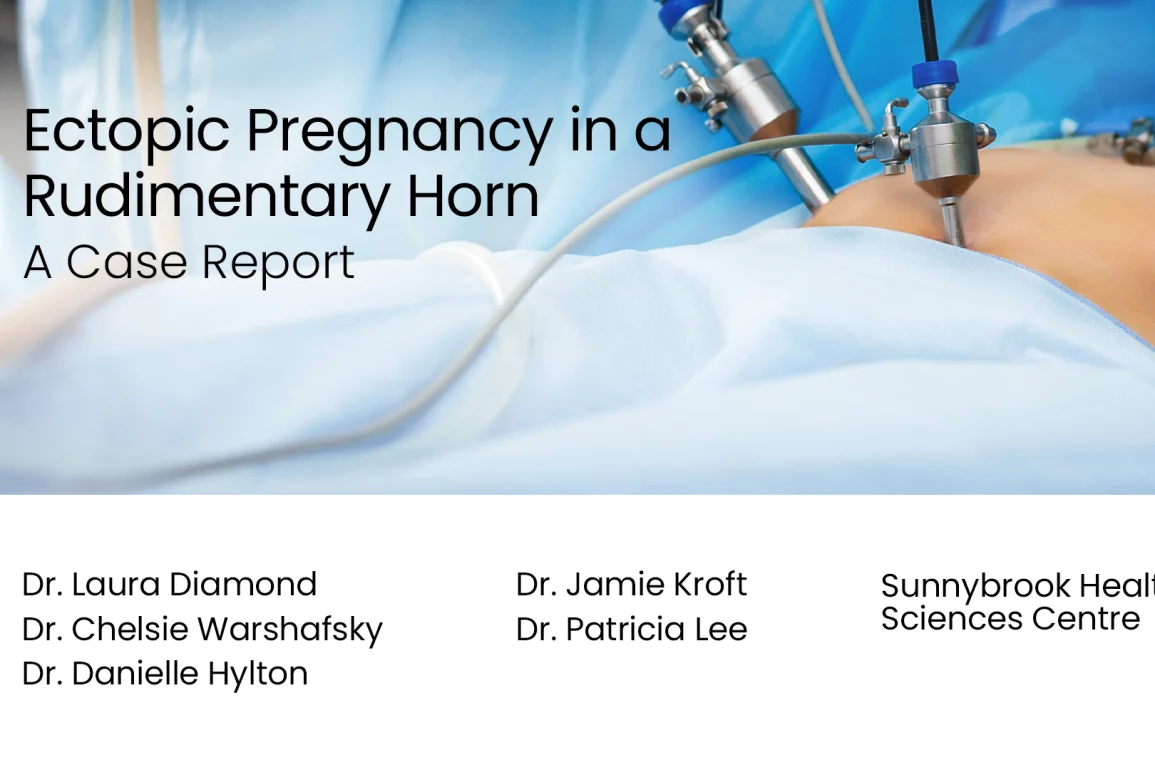Table of Contents
- Procedure Summary
- Authors
- Youtube Video
- What is Ectopic Pregnancy in a Rudimentary Horn?
- What are the Risks of Ectopic Pregnancy in a Rudimentary Horn?
- Video Transcript
Video Description
Case report detailing the diagnosis and laparoscopic management of an ectopic pregnancy in a rudimentary uterine horn, with emphasis on imaging and surgical care.
Presented By
Affiliations
Sunnybrook Health Sciences Centre
Watch on YouTube
Click here to watch this video on YouTube.
What is Ectopic Pregnancy in a Rudimentary Horn?
Ectopic pregnancy in a rudimentary horn is a rare and high-risk form of ectopic pregnancy where the embryo implants within a small, underdeveloped uterine remnant. A few key details include:
-
Definition and Anatomy: A rudimentary horn is an underdeveloped uterine segment associated with a unicornuate uterus. About two-thirds of unicornuate uteri have a rudimentary horn, and roughly 85% of these horns are non-communicating with the main uterine cavity.
-
Incidence: This condition is extremely rare, estimated to occur in only 1 in 75,000–150,000 pregnancies.
-
Pathophysiology: In a communicating horn, sperm can reach the horn through the uterine cavity. In a non-communicating horn, sperm likely migrate transperitoneally to fertilize an ovum within the horn.
-
Clinical Presentation: Patients may have amenorrhoea, pelvic or abdominal pain, abnormal vaginal bleeding, or gastrointestinal symptoms, though up to 40% remain asymptomatic until complications develop.
-
Diagnosis: Transvaginal ultrasound is often the first imaging tool, but MRI is more sensitive and may be needed to confirm the uterine anomaly and identify the pregnancy.
-
Management: Because of the high risk of rupture, surgical excision of the pregnant rudimentary horn is the standard treatment, typically performed laparoscopically or by laparotomy. Medical therapy (e.g., methotrexate) has been reported in selected cases but is generally less reliable and often followed by surgery.
What are the Risks of Ectopic Pregnancy in a Rudimentary Horn?
Video Transcript:
Ectopic pregnancy in a Rudimentary Horn. A Case Report. We have no disclosures to report. Please note, both verbal and written patient consent were obtained prior to initiation of this case report. This video will provide background on the incidence, pathophysiology, diagnosis, and management of rudimentary horn ectopic pregnancies, present a case of a rudimentary horn pregnancy at our academic centre, and demonstrate the surgical technique for management.
What is a rudimentary horn? Two thirds of individuals with a unicornuate uterus have a smaller second piece of uterus known as the rudimentary horn. 85% of these are not communicating with the unicornuate uterus. Pregnancy in the rudimentary horn is an extremely rare event, suspected to occur in one in 75,000 to 150,000 pregnancies. While rare, these pregnancies carry a high rate of maternal morbidity and mortality, with a 50 to 80% rate of rupture and significant haemorrhage, and a 0.5% rate of maternal death if ruptured.
The pathophysiology for a pregnancy in a communicating horn is congruent with that of a standard pregnancy as the sperm can access the rudimentary horn via the unicornuate uterus and the connecting endometrium. However, in a non-communicating horn, it is hypothesised that the sperm migrates transperineally from the opposite tube and enters the rudimentary horn.
Patients may present with amenorrhoea or abnormal vaginal bleeding, vague abdominal, pelvic, or lower back pain, or nausea, vomiting, and diarrhoea, however, 40% of patients with rudimentary horn pregnancies are asymptomatic. While a quantitative beta hCG will provide initial diagnosis of pregnancy most rudimentary horn ectopic pregnancies are diagnosed via transvaginal ultrasound. MRI, however, is more sensitive and may be necessary to better characterise mullerian anomalies.
Given the high risk of rupture and its associated morbidity and mortality, surgical excision of the horn is recommended and may be performed via laparoscopy or laparotomy. Some case reports note medical management was systemic and or intra-sacular methotrexate and intracardiac potassium chloride or lidocaine. In addition, some report initial medical management, followed by a scheduled horn excision at a later date.
We will now present a case of a rudimentary horn ectopic pregnancy managed at our academic institution. A 36-year-old gravida 4 para 1 presented to the emergency department with vague abdominal pain and one day of loose stools after a dating ultrasound done in the community which questioned a pregnancy in the right adnexa. She had previously had two first trimester miscarriages, followed by one prior term vaginal delivery. She was otherwise healthy.
In the emergency department her beta hCG was 86,900 international units per litre. Her community ultrasound was reviewed, which noted the aforementioned query adnexal pregnancy, with dates corresponding to seven weeks and two days. Of note, this patient had had a prior MRI in 2020 that revealed a right unicornuate uterus with a left suspected non-communicating rudimentary horn. The report from her pelvic and transvaginal ultrasound in the emergency department denoted a suspected bicornuate uterus configuration with a gestational sac in the left horn.
The current ultrasound films and the 2020 MRI images that were taken in the non-pregnant state four years prior were reviewed with the staff radiologist. The final conclusion was that this was indeed a rudimentary horn ectopic pregnancy. The result was communicated to the patient, and medical versus surgical management were discussed with a strong recommendation for surgical management. Risks were reviewed, including possible hysterectomy. Consent was obtained, and the patient was booked for an urgent laparoscopic excision of the rudimentary horn.
Here, the unicornuate uterus and the pregnant rudimentary horn are clearly visualised. In the standard fashion, the left rudimentary horn was detached from the left adnexa. The connection between the unicornuate uterus and the horn was found to be quite narrow.
Sometimes this connection is broader and more vascular, and in those cases, suturing may be required, but in our case, we were able to use a bipolar vessel sealing device for efficiency, desiccating and transecting this attachment. Haemostasis was assured, and the detached rudimentary horn was removed in a specimen bag.
In conclusion, while extremely rare, rudimentary horn ectopic pregnancy carries a high associated morbidity and mortality. Patients may present with vague pain, abnormal bleeding, or amenorrhoea, or GI symptoms, however, often they are asymptomatic. While transvaginal ultrasound is widely used for diagnosis, as seen in this case, MRI and or previous imaging may be much more helpful in characterising uterine anomalies. Finally, surgical management, either via laparoscopy or laparotomy, is recommended.



